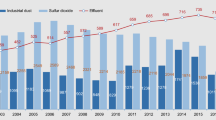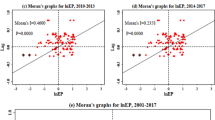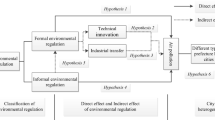Abstract
Along with monitoring air pollution level and rapid economic growth in China, the government has paid attention to the environmental policy innovation (EPI) capacity of local governments. However, scholarly research has not yet clarified the ability of local governments in EPI and its related drivers and impacts. This study explores the dynamic relations between EPI, air pollution, and the economy for the first time, using the simultaneous equation model (SEM) in China during 2006–2015 across 30 provinces. To calculate EPI, this study introduces the comprehensive concept of policy innovation, consisting of invention, diffusion, and evaluation. The results show that EPI is strongly promoted by air pollution; however, promoting EPI alone cannot decrease air pollution. These results would vary among eastern and western provinces. Economic growth has a significant positive effect on EPI and can significantly reduce air pollution. This study suggests policymakers strengthen EPI in order to achieve a balance between air pollution and economic growth.
Similar content being viewed by others
Notes
SEM, using maximum likelihood (ML) estimation, provides less biased and more efficient results compared to the generalized method of moments (GMM) (Allison et al. 2017).
EPI is the unobserved endogenous variable which is defined as a latent variable with three measurements.
References
Adam BJ, Richard GN, Robert NS (2002) Environmental policy and technological change. Environ Resour Econ 22:41–69
Aibinu AA, Al-Lawati AM (2010) Using PLS-SEM technique to model construction organizations' willingness to participate in e-bidding. Autom Constr 19:714–724
Allison PD, Williams R, Moral-Benito EJS (2017) Maximum likelihood for cross-lagged panel models with fixed effects 3:2378023117710578
Azimi M, Feng F, Yang Y (2018) Air pollution inequality and its sources in SO2 and NOX emissions among Chinese provinces from 2006 to 2015. Sustainability 10:367
Barbieri N, Ghisetti C, Gilli M, Marin G, Nicolli F (2016) A survey of the literature on environmental innovation based on main path analysis. J Econ Surv 30:596–623
Bergek A, Berggren C (2014) The impact of environmental policy instruments on innovation: a review of energy and automotive industry studies. Ecol Econ 106:112–123
Biesenbender S, Tosun JJGEC (2014) Domestic politics and the diffusion of international policy innovations: how does accommodation happen? Glob Environ Chang 29:424–433
CAAC (2013) China clean air policy briefings “ twelfth five-year plan” on airpollution prevention and control in key regions. Secretariat for Clean Air Alliance of China, China
Cai X, Che X, Zhu B, Zhao J, Xie R (2018) Will developing countries become pollution havens for developed countries? An empirical investigation in the belt and road. J Clean Prod 198:624–632
Chen Q, Zhang Y, Ekroos A (2007) Comparison of China’s environmental impact assessment (EIA) law with the European Union (EU) EIA directive. Environmental Monitoring Assessment 132:53–65
Chin, W. W. J. M. m. f. b. r. (1998) The partial least squares approach to structural equation modeling. 295:295–336
2007–2016. China Environment Yearbook. China Environment Yearbook Publishing House, Beijing, China
Cronbach LJJ p. (1951) Coefficient alpha and the internal structure of tests. 16:297-334
de Oña J, de Oña R, Eboli L, Mazzulla G (2013) Perceived service quality in bus transit service: a structural equation approach. Transp Policy 29:219–226
Ding L, Liu C, Chen K, Huang Y, and Diao B. J. J. o. e. m (2017) Atmospheric pollution reduction effect and regional predicament: an empirical analysis based on the Chinese provincial NOx emissions. 196:178–187
Dong Y, Ishikawa M, Liu X, Hamori S (2011) The determinants of citizen complaints on environmental pollution: an empirical study from China. J Clean Prod 19:1306–1314
Eisenbarth S (2017) Is Chinese trade policy motivated by environmental concerns. Journal of Environmental Economics Management 82:74–103
Fornell C, Larcker DF (1981) Evaluating structural equation models with unobservable variables and measurement error. J Mark Res 18:39–50
Fu J, Geng Y (2019) Public participation, regulatory compliance and green development in China based on provincial panel data. J Clean Prod 230:1344–1353
Gilli, M., M. Mazzanti, and F. J. T. J. o. S.-E. Nicolli (2013) Sustainability and competitiveness in evolutionary perspectives: Environmental innovations, structural change and economic dynamics in the EU. 45:204–215
Grossman, G. M., and A. B. Krueger. 1991. Environmental impacts of a North American free trade agreement. National Bureau of Economic Research
Guo L l, Qu Y, Tseng M-L (2017) The interaction effects of environmental regulation and technological innovation on regional green growth performance. J Clean Prod 162:894–902
Guo Y, Xia X, Zhang S, and Zhang D (2018) Environmental regulation, Government R&D Funding and Green Technology Innovation: Evidence from China Provincial Data Sustainability 10
Hair JF, Black WC, Babin BJ, Anderson RE (2010) Multivariate data analysis, 7th edn. Pearson Prentice Hall, New Jersey
Hao, Y., Q. Zhang, M. Zhong, and Li B. J. J. o. C. P. (2015) Is there convergence in per capita SO2 emissions in China? An empirical study using city-level panel data 108:944–954
Hildén M, Jordan A, Rayner T (2014) Climate policy innovation: developing an evaluation perspective. Environmental Politics 23:884–905
Howlett MJGEC (2014) Why are policy innovations rare and so often negative? Blame avoidance and problem denial in climate change policy-making. Glob Environ Chang 29:395–403
Huitema D, Meijerink S (2017) The generation, diffusion, and impact of innovations in global water governance. Journal of the Southwest 59:83–105
Jordan A, Huitema D (2014a) Policy innovation in a changing climate: sources, patterns and effects. Glob Environ Chang 29:387–394
Jordan A, Huitema D (2014b) Innovations in climate policy: conclusions and new directions. Environmental Politics 23:906–925
Junyi, S. J. C. E.R. (2006) A simultaneous estimation of environmental Kuznets curve: evidence from China. 17:383–394
Kaiser HF (1974) An index of factorial simplicity. Psychometrika 39:31–36
Kostka G, Hobbs W (2012) Local energy efficiency policy implementation in China: bridging the gap between National Priorities and local interests. China Q 211:765–785
Krause RM (2011) Policy innovation, intergovernmental relations, and the adoption of climate protection initiatives by US cities. J Urban Aff 33:45–60
Lesnikowski AC, Ford JD, Berrang-Ford L, Barrera M, Berry P, Henderson J, Heymann SJ (2013) National-level factors affecting planned, public adaptation to health impacts of climate change. Glob Environ Chang 23:1153–1163
Li R, Ramanathan R (2018) Exploring the relationships between different types of environmental regulations and environmental performance: evidence from China. J Clean Prod 196:1329–1340
Li B, Wu S (2017) Effects of local and civil environmental regulation on green total factor productivity in China: a spatial Durbin econometric analysis. J Clean Prod 153:342–353
Lin Q, Chen G, Du W, and Niu H (2012) Spillover effect of environmental investment: evidence from panel data at provincial level in China. Frontiers of Environmental Science Engineering in China 6:412–-420.
Lo CW, Tang S, Chan S (1997) The political economy of EIA in Guangzhou. Environ Impact Assess Rev 17:371–382
Lu Z-N, Chen H, Hao Y, Wang J, Song X, Mok TM (2017) The dynamic relationship between environmental pollution, economic development and public health: evidence from China. J Clean Prod 166:134–147
Marin G, and M Mazzanti (2013) The evolution of environmental and labor productivity dynamics. Journal of evolutionary economics 23:357-399
Massey E, Biesbroek R, Huitema D, Jordan A (2014) Climate policy innovation: the adoption and diffusion of adaptation policies across Europe. Glob Environ Chang 29:434–443
Mazzanti, M., G. Marin, S. Mancinelli, and F. J. E. Nicolli. 2015. Carbon dioxide reducing environmental innovations, sector upstream/downstream integration and policy: evidence from the EU. 42:709-735
MEP (2007-2011) Annual report on environmental statistics Ministry of Environmental Protection of the People’s republic of China. Beijing, China
NBS (2007-2016) China statistical yearbook. National bureau of statistics of China. Beijing, China
NPS (2014) Environmental protection law of the People's Republic of China the National People's Congress
Nunnally JC (1994) Psychometric theory 3E. Tata McGraw-Hill Education
Omri A, Nguyen DK, Rault CJEM (2014) Causal interactions between CO2 emissions. FDI, and economic growth: Evidence from dynamic simultaneous-equation models 42:382–389
Peters BGJWEP (1997) Policy transfers between governments: the case of administrative reforms. West Eur Polit 20:71–88
Popp DJJoEE (2006) International innovation and diffusion of air pollution control technologies: the effects of NOX and SO2 regulation in the US, Japan, and Germany. Journal of Environmental Economics Management 51:46–71
Porter ME, Linde V d (1995) Toward a new conception of the environment-competitiveness relationship. J Econ Perspect 9:97–118
Ran R (2017) Understanding blame politics in China's decentralized system of environmental governance: actors, strategies and context. China Q 231:634–661
Saidi K, Hammami SJSC, Society (2015) The impact of energy consumption and CO2 emissions on economic growth: fresh evidence from dynamic simultaneous-equations models. Sustain Cities Soc 14:178–186
Sapat A (2004) Devolution and innovation: the adoption of state environmental policy innovations by administrative agencies. Public Adm Rev 64:141–151
Schaffrin A, Sewerin S, Seubert S (2014) The innovativeness of national policy portfolios – climate policy change in Austria, Germany, and the UK. Environmental Politics 23:860–883
Semeijn J, Gelderman CJ, Schijns JMC, van Tiel R (2019) Disability and pro environmental behavior – an investigation of the determinants of purchasing environmentally friendly cars by disabled consumers. Transp Res Part D: Transp Environ 67:197–207
Shin S (2013) China's failure of policy innovation: the case of Sulphur dioxide emission trading. Environmental Politics 22:918–934
Shin K (2018) Environmental policy innovations in China: a critical analysis from a low-carbon city. Environmental Politics 27:830–851
Stadelmann M, Castro P (2014) Climate policy innovation in the south – domestic and international determinants of renewable energy policies in developing and emerging countries. Glob Environ Chang 29:413–423
Swart R, Biesbroek R, Binnerup S, Carter TR, Cowan C, Henrichs T, Loquen S, Mela H, Morecroft M, Reese M (2009) Europe adapts to climate change-comparing national adaptation strategies. Helsinki, PEER
Tao S, Zheng T, Lianjun TJCER (2008) An empirical test of the environmental Kuznets curve in China: a panel cointegration approach. 19:381–392
Teng X, Lu D, Chiu YJE (2019) Emission reduction and energy performance improvement with different regional treatment intensity in China. 12:1-18
Tie M, Qin M, Song Q, Qi Y (2020) Why does the behavior of local government leaders in low-carbon city pilots influence policy innovation? Resour Conserv Recycl 152
Vermeer EBJTCQ (1998) Industrial pollution in China and remedial policies. 156:952–985
Wang Y, Wang Y, Zhou J, Zhu X, and Lu GJEP (2011) Energy consumption and economic growth in China: a multivariate causality test. 39:4399-4406
Wang X., Zhen F, Huang X, Zhang M, Liu ZJT, and U. S. Technology. 2013. Factors influencing the development potential of urban underground space: structural equation model approach. 38:235-243
Wang H, Zhang Y, Lu X, Nielsen CP, Bi J (2015) Understanding China′s carbon dioxide emissions from both production and consumption perspectives. Renew Sust Energ Rev 52:189–200
Wang Y, Han R, Kubota J (2016) Is there an environmental Kuznets curve for SO2 emissions? A semi-parametric panel data analysis for China. Renew Sust Energ Rev 54:1182–1188
Wheaton B, Muthen B, Alwin DF, and Summers GFJSm (1977) Assessing reliability and stability in panel models. 8:84–136
Wooldridge J m (2015) Textbook introductory econometrics
Xie R-H, Yuan Y-J, Huang J-J (2017) Different types of environmental regulations and heterogeneous influence on “green” productivity: evidence from China. Ecol Econ 132:104–112
Xu S-C, Miao Y-M, Gao C, Long R-Y, Chen H, Zhao B, Wang S-X (2019) Regional differences in impacts of economic growth and urbanization on air pollutants in China based on provincial panel estimation. J Clean Prod 208:340–352
Zhang, C., and Y. J. E. P. Lin. 2012. Panel estimation for urbanization, energy consumption and CO2 emissions: a regional analysis in China. 49:488-498
Zhang KM, Wen ZG (2008) Review and challenges of policies of environmental protection and sustainable development in China. J Environ Manag 88:1249–1261
Zhang X, Geng G, Sun P (2017) Determinants and implications of citizens’ environmental complaint in China: integrating theory of planned behavior and norm activation model. J Clean Prod 166:148–156
Zhao B, Wang S, Wang J, Fu JS, Liu T, Xu J, Fu X, Hao J (2013) Impact of national NOx and SO2 control policies on particulate matter pollution in China. Atmos Environ 77:453–463
Zhao X, Liu C, Yang M (2018) The effects of environmental regulation on China's total factor productivity: an empirical study of carbon-intensive industries. J Clean Prod 179:325–334
Acknowledgments
The authors express sincere gratitude to three anonymous reviewers for their helpful comments to improve the quality of this paper.
Author information
Authors and Affiliations
Corresponding authors
Additional information
Responsible editor: Eyup Dogan
Publisher’s note
Springer Nature remains neutral with regard to jurisdictional claims in published maps and institutional affiliations.
Electronic supplementary material
ESM 1
(DOCX 837 kb)
Rights and permissions
About this article
Cite this article
Azimi, M., Feng, F. & Zhou, C. Environmental policy innovation in China and examining its dynamic relations with air pollution and economic growth using SEM panel data. Environ Sci Pollut Res 27, 9987–9998 (2020). https://doi.org/10.1007/s11356-020-07644-4
Received:
Accepted:
Published:
Issue Date:
DOI: https://doi.org/10.1007/s11356-020-07644-4




